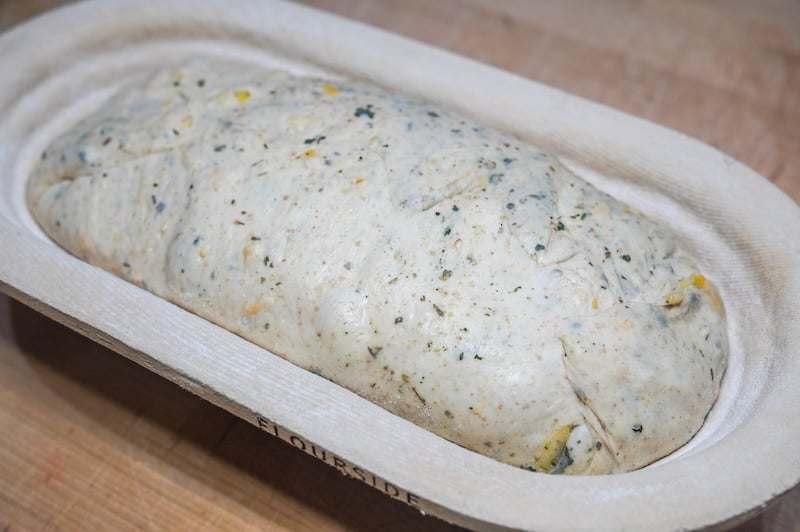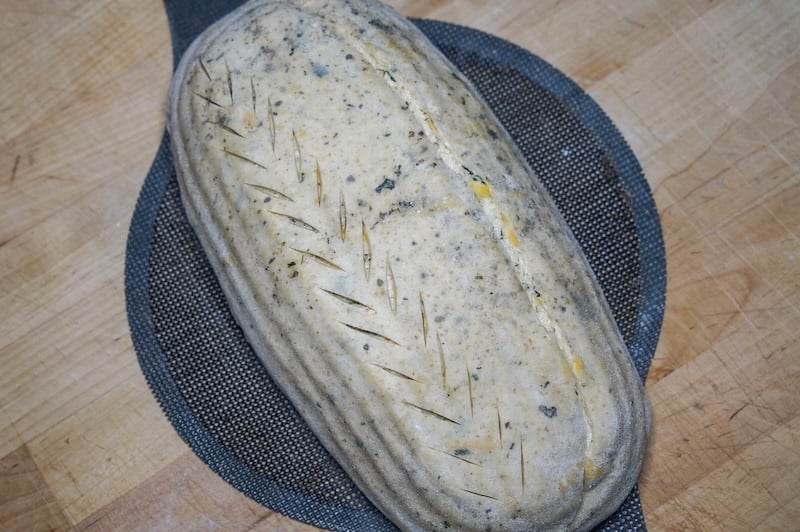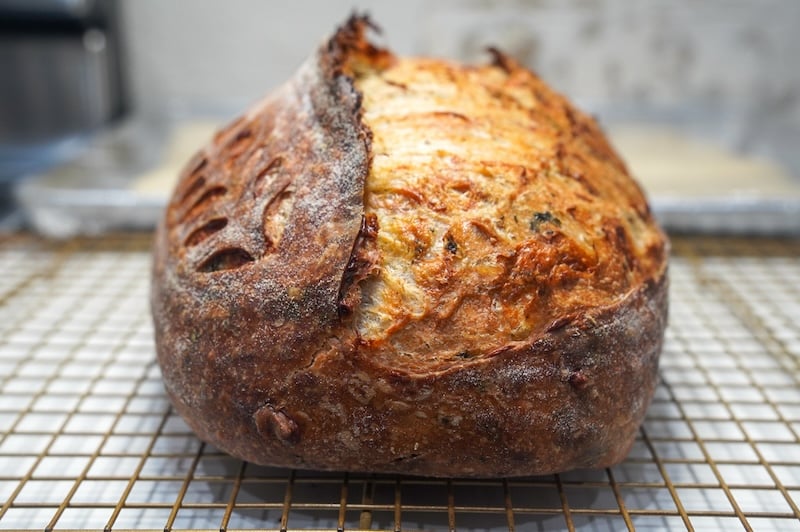Italian Herbs and Cheese Artisan Sourdough Bread

INGREDIENTS
Sourdough Starter
- 12 g sourdough starter (active or discard)
- 60 g water
- 60 g bread flour (unbleached, King Arthur)
Main Dough
- 325 g water
- 450 g bread flour (unbleached, King Arthur)
- 50 g whole wheat flour (Sunrise Flour Mills)
- 120 g active sourdough starter (from above)
- 25 g water
- 10 g sea salt (Redmonds)
Inclusions
- 3 g Italian seasoning blend
- 4 g lightly dried basil
- 110 g Colby jack cheese, shredded
- 15 g Parmigiano Reggiano, shredded
Equipment
- Oval banneton (5% off with code TSG5) | Size I'm Using: Oval – Spiral MD
- Dutch oven ($15 off with code REBEKAH15)
Instructions
Feed Your Starter
- The night before you plan to make your dough, feed your starter. Mix together 12 g sourdough starter, 60 g water, and 60 g bread flour. This gives you a little more than you need so you don't have to scrape out every last bit from the jar (you can also feed the leftovers to maintain your starter). At this feeding ratio, your starter should peak by morning (about 10-12 hours after you feed).
Make the Dough
- In the morning, mix 450 g bread flour, 50 g whole wheat flour, 120 g active sourdough starter, and 325 g water. (This is the beginning of the bulk fermentation.) Knead the ingredients together until fully incorporated and you have a shaggy dough. Cover with plastic wrap, a shower cap bowl cover, or cloth bowl cover, and let rest for about 1 hour.Optional: you can opt to do an autolyse by mixing just the flours and water and letting it rest for 30 minutes, up to overnight. Then, proceed by adding your starter.
- Add 10 g sea salt and 25 g water. Dimple in and squeeze the saltwater into the flour. The dough will break up, get stringy, and feel rubbery. This is normal. Mist your counter with water and turn out the mass of dough onto your counter. Do slap and folds for 2-4 minutes, or until the dough smooths out and the saltwater is fully incorporated. Cover and let rest for 30 minutes.
- Add inclusions (3 g Italian seasoning blend, 4 g lightly dried basil, 110 g Colby jack cheese, shredded, and 15 g Parmigiano Reggiano, shredded) on top of the dough in the bowl. Stretch and fold the inclusions into the dough. Cover and let rest for 30 minutes.
- Stretch and fold the dough. Cover and let rest for 30 minutes.
- Coil fold the dough. Cover and let rest for 30 minutes.
- Coil fold the dough. Cover and let rest for 30 minutes.
- The dough strengthening is now completed, so we wait until the dough has finished its bulk fermentation.Bulk fermentation is done when the dough is visibly larger (the exact percentage rise is not as important as the other visual signs), with bubbles all around the sides and underneath the surface. The dough should jiggle like jelly when you shake the bowl and feel light, airy, and puffy to the touch. It should be domed on the edges where the dough meets the bowl. Don’t worry about exact timing; trust these visual and tactile cues to guide you. Warmer dough ferments faster, colder dough takes longer, but slightly overproofed dough often makes better bread than underproofed. Don't be afraid to push the limits. For me, bulk fermentation took 7.5 hours; my dough was 70-72°F (21-22°C) and my home was 71°F (21.6°C), for reference.
- When bulk fermentation is done, dump out dough onto the counter. Gently pre-shape using a bench scraper to coax the dough into a tight ball. This is the end of the bulk fermentation.

- Final shape the dough using the single caddy clasp method. Flip into a floured banneton, seam-side up. Pinch the seam shut. Optional: Let the dough rest for about 10 minutes. Stitch the top of the dough to increase surface tension and cover. Put in the fridge overnight.

Score & Bake
- The next day, at any time, preheat oven to 450°F/230°C with a Dutch oven inside.
- Score the dough and place it in the preheated Dutch oven. Cover and bake for 30 minutes.

- Remove lid and lower oven temperature to 425°F/220°C. Bake for an additional 15-20 minutes, or until the top is as golden brown as you prefer. Feel free to temp the bread to ensure it is fully baked. It should be around 205-210°F (96-99°C).
- Wait for the bread to cool down, about 2 hours. Cut into the cooled bread and enjoy!!

Video
Notes
Lightly dried basil: To clarify, this isn't dried basil in a spice jar. It's found in the produce section and lasts up to 4 weeks in the fridge. It's basically halfway between fresh basil and dried basil.
To make two loaves, simply double the recipe.